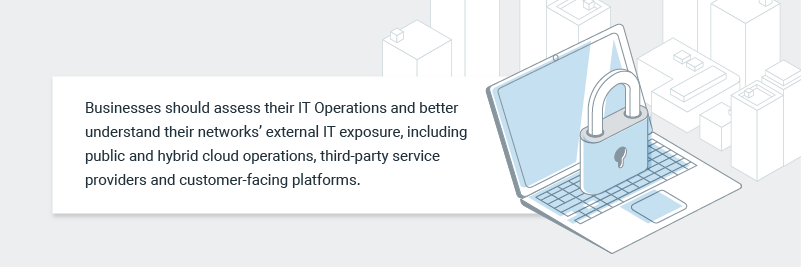
Preparing your company to go public is a substantial undertaking, and it can be difficult to keep track of all of the different alterations and improvements that are necessary.
With all of the various complications at play, it’s important to keep cybersecurity at the forefront. As a public company, you’ll have to meet certain regulatory requirements for the disclosure of specific cybersecurity incidents. Falling victim to an attack or having a vulnerability exposed carries its own bad press and can damage trust with organizational stakeholders, but there are additional operational and compliance implications your business might face.
If you don’t have the right people, processes and technology in place to catch deficiencies and remediate them in advance of a potential incident, there’s a significant possibility that your company could be fined following a disclosure.
That’s what happened to a real estate settlement services company in June, according to a press release from the Securities and Exchange Commission (SEC). In May, the business was informed of a vulnerability by a journalist. After filing a Form 8-K and releasing a public statement, it was found that the company’s disclosure controls were deficient. The vulnerability had been discovered previously, but it had not been fixed or reported up to senior leadership, so investors were not notified. Ultimately, the business consented to pay $487,616 in penalties without admitting to or denying the conclusions.
As a public company, you have important responsibilities when it comes to finding and fixing relevant issues, as well as ensuring that proper procedures are in place for disclosing potential problems.
We’ll help you explore some of the key cybersecurity elements that you need to be aware of as you prepare to go public, including:
- The ins and outs of your current state and respective maturity levels against industry peers.
- The readiness and effectiveness of your cybersecurity framework as a public company.
- Incident management in the public eye.
Federal, state and international requirements preparedness
As you prepare to go public, your compliance needs substantially increase. There are various regulatory requirements (both federal and state mandated), data privacy laws and international standards that publicly traded companies are expected to comply with.
The first step toward elevating your cybersecurity posture and preparing yourself to become compliant is to conduct an assessment of how stable, secure and mature your IT operating environment is. This way, you can identify existing deficiencies and create a plan for achieving compliance with pertinent standards and regulations.
In particular, businesses should assess their IT Operations and better understand their:
- Enterprise network and encompassing corporate asset landscape.
- External IT exposure, including public and hybrid cloud operations, third-party service providers and customer-facing platforms.

In addition, a thorough third-party risk assessment is essential for identifying potential risks and shortcomings throughout your digital ecosystem that are brought in by your vendor relationships. If a gap is uncovered, you’ll have to work closely with your partners to address the problem. As a public company, you can’t risk disappointing your shareholders or falling into noncompliance.
Once you understand your current operating state better, you must work towards meeting relevant regulatory requirements. For example, public companies have a high hurdle to clear when it comes to following the rules and regulations of the Sarbanes-Oxley Act (SOX). This is particularly true when it comes to data retention. A recent TechTarget article about achieving SOX compliance outlined the importance of document storage, data retention and other controls.
Lastly, you must consider data privacy laws. In today’s world, data is everything. Attacks have moved away from stealing money from organizations to stealing data and holding it as ransom (commonly referred to as ransomware). There are various privacy laws both within the US and internationally that must be adhered to depending on where your customers are located.
As you can see, there are numerous regulatory requirements that you are required to comply with depending on the nature of your company, including where you’re located, your industry and other factors.
Putting together a framework for cybersecurity as a public company
After exploring your current state and the regulatory landscape that you’ll enter as a public company, you may realize that you have a number of vulnerabilities that should be addressed, or that you have discovered new regulatory requirements that you are not compliant with.
While you can individually address the threats and vulnerabilities, it is best to develop a cybersecurity framework that aligns with industry standards. The framework must be suitable for achieving your desired outcomes and capable of addressing relevant attack vectors. Examine how your current capacity would stand up against the security and compliance challenges you might expect in your industry.
At this stage, a cybersecurity maturity assessment can be helpful for deciding which steps you need to take so you can elevate your security posture during the public readiness journey.
With the help of a dedicated partner, you can define and implement a holistic cybersecurity framework that supports best practices and industry standards. You should also examine:
- Relevant regulatory requirements, international mandates and other compliance needs.
- Roles and responsibilities of your IT department and your IT staffing needs.
Incident management
You can’t go a week without hearing of a new cybersecurity incident occurring where a company’s data or assets have been compromised. If you do experience a cybersecurity incident as a public company, aside from actually investigating, mitigating and minimizing the damage to your assets and public image, you may be required to disclose and discuss this incident with the appropriate authorities. More often than not, companies in this situation are required to file a Form 8-K.
Generally speaking, the disclosure process requires the public company to describe the event as well as remediation activities that the business completed and how they’ll attempt to implement proactive security measures moving forward. The SEC may then evaluate the incident to determine if they believe the business upheld its duties as a public company leading up to the event.
In the example we mentioned earlier, it seems that wasn’t the case.
To avoid this, you need a proactive cybersecurity strategy, a robust incident management and response program and an exhaustive understanding of all the compliance requirements and obligations that your company will be required to meet. You also need the right technology in place to prevent the likelihood of such incidents and to respond swiftly if you do experience an issue.
Remember, the goal is to improve your security posture before an incident occurs. This way you can reduce the likelihood of a security event occurring, and in the event you are impacted, you are prepared to handle the situation.
Conclusion
Public readiness campaigns have so many moving parts that it’s easy for cybersecurity to get lost in the shuffle. However, considering the expanding threat landscape and the regulatory pressure that businesses face today to be responsible stewards of the public trust, you need to invest in cybersecurity strategies. This consists of assessing the compliance landscape you’re entering, conducting an overview of your current system’s maturity and preparing for incident management scenarios.
Importantly, this strategy must be proactive. A reactive stance makes you more vulnerable not only to attackers but also to fines and reputational harm as well. Public companies have immense responsibilities that have to be met.
For help in this process, you can reach out to the experts at CFGI. Our team is prepared to offer you a free 30-minute consultation so we can get to know your needs. Ask about our pre-IPO readiness assessment for a comprehensive overview.
